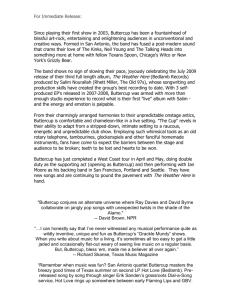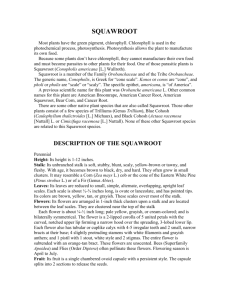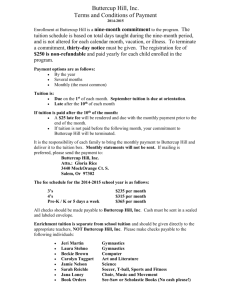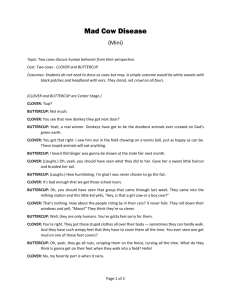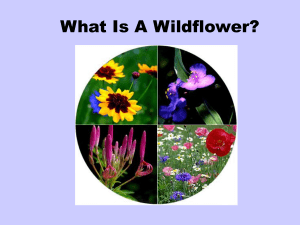kidney-leaved buttercup - Indiana Native Plant & Wildflower Society
advertisement
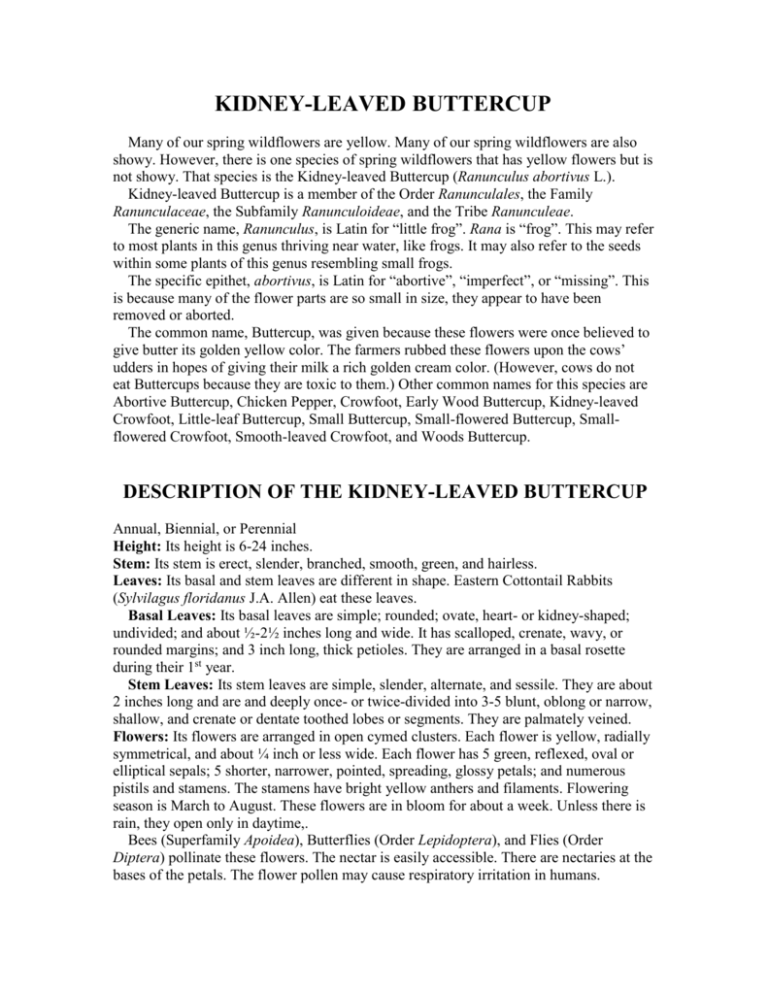
KIDNEY-LEAVED BUTTERCUP Many of our spring wildflowers are yellow. Many of our spring wildflowers are also showy. However, there is one species of spring wildflowers that has yellow flowers but is not showy. That species is the Kidney-leaved Buttercup (Ranunculus abortivus L.). Kidney-leaved Buttercup is a member of the Order Ranunculales, the Family Ranunculaceae, the Subfamily Ranunculoideae, and the Tribe Ranunculeae. The generic name, Ranunculus, is Latin for “little frog”. Rana is “frog”. This may refer to most plants in this genus thriving near water, like frogs. It may also refer to the seeds within some plants of this genus resembling small frogs. The specific epithet, abortivus, is Latin for “abortive”, “imperfect”, or “missing”. This is because many of the flower parts are so small in size, they appear to have been removed or aborted. The common name, Buttercup, was given because these flowers were once believed to give butter its golden yellow color. The farmers rubbed these flowers upon the cows’ udders in hopes of giving their milk a rich golden cream color. (However, cows do not eat Buttercups because they are toxic to them.) Other common names for this species are Abortive Buttercup, Chicken Pepper, Crowfoot, Early Wood Buttercup, Kidney-leaved Crowfoot, Little-leaf Buttercup, Small Buttercup, Small-flowered Buttercup, Smallflowered Crowfoot, Smooth-leaved Crowfoot, and Woods Buttercup. DESCRIPTION OF THE KIDNEY-LEAVED BUTTERCUP Annual, Biennial, or Perennial Height: Its height is 6-24 inches. Stem: Its stem is erect, slender, branched, smooth, green, and hairless. Leaves: Its basal and stem leaves are different in shape. Eastern Cottontail Rabbits (Sylvilagus floridanus J.A. Allen) eat these leaves. Basal Leaves: Its basal leaves are simple; rounded; ovate, heart- or kidney-shaped; undivided; and about ½-2½ inches long and wide. It has scalloped, crenate, wavy, or rounded margins; and 3 inch long, thick petioles. They are arranged in a basal rosette during their 1st year. Stem Leaves: Its stem leaves are simple, slender, alternate, and sessile. They are about 2 inches long and are and deeply once- or twice-divided into 3-5 blunt, oblong or narrow, shallow, and crenate or dentate toothed lobes or segments. They are palmately veined. Flowers: Its flowers are arranged in open cymed clusters. Each flower is yellow, radially symmetrical, and about ¼ inch or less wide. Each flower has 5 green, reflexed, oval or elliptical sepals; 5 shorter, narrower, pointed, spreading, glossy petals; and numerous pistils and stamens. The stamens have bright yellow anthers and filaments. Flowering season is March to August. These flowers are in bloom for about a week. Unless there is rain, they open only in daytime,. Bees (Superfamily Apoidea), Butterflies (Order Lepidoptera), and Flies (Order Diptera) pollinate these flowers. The nectar is easily accessible. There are nectaries at the bases of the petals. The flower pollen may cause respiratory irritation in humans. Buttercup flowers have the simplest design upon the evolutionary scale. These flowers began as modified leaves. Their ancestry goes way back into the Cenozoic Era. Fruit: Its fruit consists of an aggregate of nearly 50, dry, short beaked, flattened, smooth or slightly roughened, yellow-brown nutlets or achenes. These fruits are arranged upon a short and oval or rounded receptacle. Birds (Class Aves), such as Wood Ducks (Aix sponsa L.) and Wild Turkeys (Meleagris gallopavo L.), and small Mammals (Class Mammalia), such as Eastern Chipmunks (Tamias striatus L.) and Meadow Voles (Microtus pennsylvanicis Ord), will eat these seeds. These seeds germinate in the fall or in the spring. Roots: Its roots are fleshy, fibrous, and thread-like. They are toxic and can poison the surrounding soils. They may even kill the beneficial nitrogen-fixing bacteria. Habitat: Its habitat consists of dry or moist open woodlands, thickets, meadows, pastures, fields, rights-of-ways, and disturbed waste areas. This plant is considered a weed in many places. Range: Its range consists of the eastern and central U.S. and southeastern Canada. Toxicity: Like other Buttercups, the Kidney-leaved Buttercup is toxic to both humans and animals. Large doses can be fatal to the consumer. These toxins protect the plants from grazing animals. Its clear acrid, sap contains the yellow, unstable glycoside, ranunculin. Ranunculin is most concentrated during flowering season. Whenever the plant is damaged, enzyme actions change the ranunculin into glucose and into the toxin protoanemonin (a.k.a anemonol or ranunculol). Depending upon the concentration and upon the sensitivity of the person, external contact with protoanemonin can cause skin itching, rashes, and blisters. The toxin may cause phytophotdermatitis if the injury is exposed to sunlight. If ingested it can cause burning of the mouth, severe inflammation of the digestive system, dizziness, spasms, and paralysis. If ingested by cows, it can produce bad-tasting and reddish-tinged milk. If exposed to air while drying, protoanemonin becomes non-toxic anemonin. Dried Kidney-leaved Buttercups can be used in hay. Medicinal Uses: Despite the toxicity of the Kidney-leaved Buttercup, it did have some medicinal uses. Several Native American tribes used this plant as medicine. The roots were pulverized, soaked in water, and used as a poultice for treating cuts and wounds. The plant was also used externally to draw out pain and toxins from underlying tissues. The juice was used as a sedative. An infusion was used as a gargle for sore throats. A root decoction was used as an emetic and for treating epilepsy, smallpox, muscular aches, and nosebleeds. A root and leaf decoction was used as a wash for treating sore eyes and snakebites. The crushed leaf odor was used for treating headaches. The plant is also used as an astringent, a diuretic, and an expectorant. REFERENCES NATIONAL WILDLIFE FEDERATION FIELD GUIDE TO WILDFLOWERS OF NORTH AMERICA By David Brandenburg WILDFLOWERS IN THE FIELD AND FOREST By Steven Clements and Carol Gracie THE HISTORY AND FOLKLORE OF NORTH AMERICAN WILDFLOWERS By Timothy Coffey COMMON FLOWERING PLANTS OF THE NORTHEAST By Donald D. Cox MISSOURI WILDFLOWERS By Edgar Denison WILDFLOWERS OF ONTARIO By Timothy Dickinson, Deborah Metsger, Jenny Bull, and Richard Dickinson THE BOOK OF FOREST AND THICKET By John Eastman and Amelia Hansen WILDFLOWERS OF OHIO By Robert L. Henn IROQUOIS MEDICAL BOTANY By James W. Herrick and Dean R. Snow WILDFLOWERS AND FERNS OF INDIANA FORESTS By Michael A. Homoya MEDICINAL PLANTS OF THE HEARTLAND By Connie Kaye and Neil Billington EASTERN NORTH AMERICA’S WILDFLOWERS By Louis C. Linn NATIVE AMERICAN MEDICINAL PLANTS By Daniel E. Moerman NEWCOMB’S WILDFLOWER GUIDE By Lawrence Newcomb and Gordon Morrison WILDFLOWERS By Roger Tory Peterson and Margaret Mc Kenny WILD EDIBLE PLANTS OF NEW ENGLAND By Joan Richardson THE SECRETS OF WILDFLOWERS By Jack Sanders NATIONAL AUDUBON SOCIETY FIELD GUIDE TO WILDFLOWERS (EASTERN REGION) By John W. Thieret, William A. Niering, and Nancy C. Olmstead COMMON POISONOUS PLANTS AND MUSHROOMS OF NORTH AMERICA By Nancy J. Turner and Adam F. Szczawinski AMERICAN INDIAN MEDICINE By Virgil J. Vogel EARTH MEDICINE EARTH FOOD By Michael A. Weiner LIFE AND LORE OF ILLINOIS WILDFLOWERS By William E. Werner, Jr. POISONOUS PLANTS OF EASTERN NORTH AMERICA By Randy G. Westbrooks and James W. Preacher www.illinoiswildflowers.info/weeds/plants/sf_buttercup.htm

